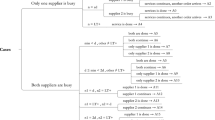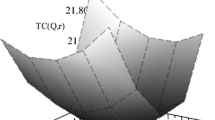Abstract
Supply contracts are designed to minimize inventory costs or to hedge against undesirable events (e.g., shortages) in the face of demand or supply uncertainty. In particular, replenishment terms stipulated by supply contracts need to be optimized with respect to overall costs, profits, service levels, etc. In this paper, we shall be primarily interested in minimizing an inventory cost function with respect to a constant replenishment rate. Consider a single-product inventory system under continuous review with constant replenishment and compound Poisson demands subject to lost-sales. The system incurs inventory carrying costs and lost-sales penalties, where the carrying cost is a linear function of on-hand inventory and a lost-sales penalty is incurred per lost sale occurrence as a function of lost-sale size. We first derive an integro-differential equation for the expected cumulative cost until and including the first lost-sale occurrence. From this equation, we obtain a closed form expression for the time-average inventory cost, and provide an algorithm for a numerical computation of the optimal replenishment rate that minimizes the aforementioned time-average cost function. In particular, we consider two special cases of lost-sales penalty functions: constant penalty and loss-proportional penalty. We further consider special demand size distributions, such as constant, uniform and Gamma, and take advantage of their functional form to further simplify the optimization algorithm. In particular, for the special case of exponential demand sizes, we exhibit a closed form expression for the optimal replenishment rate and its corresponding cost. Finally, a numerical study is carried out to illustrate the results.






Similar content being viewed by others
References
Adan, I., Boxma, O., & Perry, D. (2005). The G/M/1 queue revisited. Mathematical Methods of Operations Research, 62(3), 437–452.
Archibald, B., & Silver, E. (1978). (\(s\), \(S\)) policy under continuous review and discrete compound Poisson demands. Management Science, 24, 899–909.
Beyer, D., Cheng, F., Sethi, S. P., & Taksar, M. I. (2010). Markovian demand inventory models. International series in operations research and management science. New York, NY: Springer.
Federgruen, A., & Schechner, Z. (1983). Cost formulas for continuous review inventory models with fixed delivery lags. Operations Research, 31(5), 957–965.
Feldman, R. (1978). A continuous review (\(s\), \(S\)) inventory system in a random environment. Journal of Applied Probability, 15, 654–659.
Graves, S. C. (1982). The application of queueing theory to continuous perishable inventory systems. Management Science, 28, 400–406.
Graves, S. C., & Keilson, J. (1981). The compensation method applied to a one-product production inventory model. Mathematics of Operations Research, 6, 246–262.
Gullu, R., Jackson, P. L. (1993). On the continuous time capacitated production/inventory problem with no set up costs. ORIE technical reports.
Karr, A. F. (1993). Probability. New York: Springer.
Katehakis, M. N., & Smit, L. C. (2012). On computing optimal (\(Q\), \(r\)) replenishment policies under quantity discounts. Annals of Operations Research, 200(1), 279–298.
Li, D., & Glazebrook, K. D. (2010). An approximate dynamic programming approach to the development of heuristics for the scheduling of impatient jobs in a clearing system. Naval Research Logistics, 57(3), 225–236.
Minner, S., & Silver, E. A. (2007). Replenishment policies for multiple products with compound-Poisson demand that share a common warehouse. International Journal of Production Economics, 108(1), 388–398.
Perry, D., & Stadje, W. (2002). Exact distributions in a jump-diffusion storage model. Probability in the Engineering and Informational Sciences, 16(1), 19–27.
Perry, D., & Stadje, W. (2003). Duality of dams via mountain processes. Operations Research Letters, 31, 451–458.
Prabhu, N. U. (1965). Queues and inventories: a study of their basic stochastic processes. New York: Wiley.
Presman, E., & Sethi, S. P. (2006). Inventory models with continuous and Poisson demands and discounted and average costs. Production and Operations Management, 15(2), 279–293.
Richards, F. R. (1975). Comments on the distribution of inventory position in a continuous-review (\(s\), \(S\)) inventory system. Operations Research, 23, 366–371.
Ross, S. M. (1996). Stochastic processes (Vol. 2). New York: Wiley.
Sahin, I. (1979). On the stationary analysis of continuous review (\(s\), \(S\)) inventory systems with constant lead times. Operation Research, 27, 717–730.
Sahin, I. (1983). On the continuous review (\(s\), \(S\)) inventory model under compound renewal demand and random lead times. Journal of Applied Probability, 20, 213–219.
Shi, J., Katehakis, M. N., & Melamed, B. (2013). Martingale methods for pricing inventory penalties under continuous replenishment and compound renewal demands. Annals of Operations Research, 208(1), 593–612.
Shi, J., Katehakis, M. N., Melamed, B., & Xia, Y. (2014). Optimal continuous replenishment for a production-inventory system with compound Poisson demands and lost-sales. Operations Research, 6(5), 1048–1063.
Simchi-Levi, D., Kaminsky, P., & Simchi-Levi, E. (2008). Designing and managing the supply chain (3rd ed.). New York: McGraw-Hill/Irwin.
Springael, J., Nieuwenhuyse, I. V. (2005). A lost sales inventory model with a compound Poisson demand pattern. Working papers, University of Antwerp.
Thompstone, R., & Silver, E. (1975). A coordinated inventory control system for compound Poisson demand and zero lead time. International Journal of Production Research, 13, 581–602.
Tijms, H. C. (1972). Analysis of (\(s\)) inventory models. Amsterdam: Mathematich Centrum.
Widder, D. V. (1959). The Laplace transform. New Jersey: Princeton University Press.
Acknowledgments
The first author would like to acknowledge the support for this project from the National Science Foundation (NSF grant CMMI-14-50743). The third author was supported in part by Research Seed Grant and Startup Grant at NJIT and Seed Grant by Leir Charitable Foundation.
Author information
Authors and Affiliations
Corresponding author
Appendix
Appendix
Proof of Proposition 1
The proof of the necessary condition is trivial. To prove the sufficient condition, we first write Eq. (4.13) as
Next, for all \({\varvec{z}}>0\),
Here, the first inequality holds since \(\int _{{\varvec{x}}_0 }^{\varvec{\infty }} {{\varvec{e}}^{-{\varvec{z x}}}{\varvec{f}}({\varvec{x}}) {\varvec{dx}}} \le {\varvec{e}}^{-{\varvec{z x}}_0 }\int _{{\varvec{x}}_0 }^{\varvec{\infty }} {{\varvec{f}}({\varvec{x}}) {\varvec{dx}}} \) since \({\varvec{e}}^{-{\varvec{z x}}}\le {\varvec{e}}^{-{\varvec{z x}}_0 }\) for \({\varvec{x}}\ge {\varvec{x}}_0 \); the second equality holds by Eq. (8.1), and the last inequality holds by the relations \({\varvec{e}}^{-{\varvec{z x}}}>{\varvec{e}}^{-{\varvec{z x}}_0 }\), whence \({\varvec{e}}^{-{\varvec{z x}}}-{\varvec{e}}^{-{\varvec{z x}}_0 }>0\) for \(0\le {\varvec{x}}<{\varvec{x}}_0 \) and \({\varvec{f}}({\varvec{x}})\le 0\) but not identically zero for \(0\le {\varvec{x}}<{\varvec{x}}_0 \). This completes the proof. \(\square \)
Proofs of Table 1 Formulas
(1) Constant demand size
Consider the first distribution row of Table 1, where \({\varvec{D}}={\varvec{d}}>0\) is a constant, so that
The corresponding \({\varvec{\xi }}^{*}\) follows by substituting Eq. (8.2) into Eq. (5.6), the corresponding \({\varvec{\rho }}^{*}\) follows by substituting this \({\varvec{\xi }}^{*}\) and Eq. (8.2) into Eq. (3.28), and the corresponding \(\bar{{{\varvec{c}}}}_{{\varvec{\rho }}^*} \) follows by substituting \({\varvec{\xi }}^{*}\) and \({\varvec{\rho }}^{*}\) into Eq. (5.5).
(2) Exponentially-distributed demand size
Consider the second distribution row of Table 1, where \({\varvec{D\sim }}\, \mathrm{Exp}({\varvec{\beta }} )\). Substituting Eq. (5.14) into Eq. (5.5) yields
The corresponding \({\varvec{\xi }}^{*}\) is obtained by straightforward minimization of Eq. (8.3) in \({\varvec{\xi }}\), the corresponding \({\varvec{\rho }}^{*}\) follows by substituting this \({\varvec{\xi }}^{*}\) into Eq. (5.16), and the corresponding \(\bar{{{\varvec{c}}}}_{{\varvec{\rho }}_*} \) follows by substituting this \({\varvec{\xi }}^{*}\) into Eq. (8.3).
(3) Uniformly-distributed demand size
Consider the third distribution row of Table 1, where \({\varvec{D\sim }}\,{\varvec{U}}({\varvec{a,b}})\), so that
The corresponding \({\varvec{\xi }}^{*}\) follows by substituting Eq. (8.4) into Eq. (5.6), the corresponding \({\varvec{\rho }}^{*}\) follows by substituting this \({\varvec{\xi }}^{*}\) and Eq. (8.4) into Eq. (3.28), and the corresponding \(\bar{{{\varvec{c}}}}_{{\varvec{\rho }}^*} \) follows by substituting \({\varvec{\xi }}^{*}\) and \({\varvec{\rho }}^{*}\) into Eq. (5.5).
(4) Gamma-distributed demand size
Consider the fourth distribution row of Table 1, where \({\varvec{D\sim \varGamma }} ({\varvec{\alpha ,\beta }} )\), so that
The corresponding \({\varvec{\xi }}^{*}\) follows by substituting Eq. (8.5) into Eq. (5.6), the corresponding \({\varvec{\rho }}^{*}\) follows by substituting this \({\varvec{\xi }}^{*}\) and Eq. (8.5) into Eq. (3.28), and the corresponding \(\bar{{{\varvec{c}}}}_{{\varvec{\rho }}^*}\) follows by substituting \({\varvec{\xi }}^{*}\) and \({\varvec{\rho }}^{*}\) into Eq. (5.5). \(\square \)
Proofs of Table 2 Formulas
(1) Constant demand size
Consider the first distribution row of Table 2, where \({\varvec{D}}={\varvec{d}}\). Then, the corresponding \({\varvec{\xi }}^{*}\) follows by substituting Eq. (8.2) into Eq. (5.11), the corresponding \({\varvec{\rho }}^{*}\) follows by substituting this \({\varvec{\xi }}^{*}\) and Eq. (8.2) into Eq. (3.28), and the corresponding \(\bar{{{\varvec{c}}}}_{{\varvec{\rho }}^*} \) follows by substituting \({\varvec{\xi }}^{*}\) and \({\varvec{\rho }}^{*}\) into Eq. (5.10).
(2) Exponentially-distributed demand size
Consider the second distribution row of Table 2, where \({\varvec{D}}\,{\varvec{\sim }}\,\mathrm{Exp}({\varvec{\beta }})\). Substituting Eq. (5.14) into Eq. (5.9) yields,
The corresponding \({\varvec{\xi }}^{*}\) is obtained by straightforward minimization of Eq. (8.6), the corresponding \({\varvec{\rho }}^{*}\) follows by substituting this \({\varvec{\xi }}^{*}\) into Eq. (5.16), and the corresponding \(\bar{{{\varvec{c}}}}_{{\varvec{\rho }}^*}\) follows by substituting this \({\varvec{\xi }}^{*}\) into Eq. (8.6).
(3) Uniformly-distributed demand size
Consider the third distribution row of Table 2, where \({\varvec{D\sim U}}({\varvec{a,b}})\). Then, the corresponding \({\varvec{\xi }}^{*}\) follows by substituting Eq. (8.4) into Eq. (5.11), the corresponding \({\varvec{\rho }}^{*}\) follows by substituting this \({\varvec{\xi }}^{*}\) and Eq. (8.4) into Eq. (3.28), and the corresponding \(\bar{{{\varvec{c}}}}_{{\varvec{\rho }}^*}\) follows by substituting \({\varvec{\xi }}^{*}\) and \({\varvec{\rho }}^{*}\) into Eq. (5.10).
(4) Gamma-distributed demand size
Consider the fourth distribution row of Table 2, where \({\varvec{D\sim \varGamma }} ({\varvec{\alpha ,\beta }} )\). Then, the corresponding \({\varvec{\xi }}^{*}\) follows by substituting Eq. (8.5) into Eq. (5.11), the corresponding \({\varvec{\rho }}^{*}\) follows by substituting this \({\varvec{\xi }}^{*}\) and Eq. (8.5) into Eq. (3.28), and the corresponding \(\bar{{{\varvec{c}}}}_{{\varvec{\rho }}^*}\) follows by substituting \({\varvec{\xi }}^{*}\) and \({\varvec{\rho }}^{*}\) into Eq. (5.10). \(\square \)
Proof of Proposition 2
Assume first that the lost-sales penalty is of the form \({\varvec{w}}({\varvec{x}})=1_{(\varvec{0},\infty )} ({\varvec{x}}) {\varvec{K}}_0 \) (see Sect. 6.1). Substituting Eq. (5.16) into Eq. (5.5), we have
where the time-average carrying cost is
and the time-average lost-sales penalty is
Next, equate Eqs. (8.8) and (8.9) and solve for \(\hat{{{\varvec{\rho }} }}\), yielding
Letting \({\varvec{a}}=\frac{{\varvec{h}}}{2 {{\varvec{K}}}_0 {\varvec{\beta }}^{2}}>0\) and \({\varvec{b}}=\sqrt{ \frac{{\varvec{\lambda h}}}{{{\varvec{K}}}_0 {\varvec{\beta }}^{3}}}>0\) above, and noting that \(\sqrt{{\varvec{a}}^{2}+{\varvec{b}}^{2}}<{\varvec{a}}+{\varvec{b}}\), we get
Equations (8.10) and (8.11) readily imply
where the equality in Eq. (8.12) follows from the exponential case in Table 1. This completes the proof of Eq. (5.17).
To prove Eq. (5.18), note first that \(\bar{{{\varvec{h}}}}_{\varvec{\rho }}\) is an increasing function of \({\varvec{\rho }} \) by part (a) of Lemma 6, while \(\bar{{{\varvec{w}}}}_{\varvec{\rho }} \) is a decreasing function of \({\varvec{\rho }} \) by part (b) of Lemma 6. Second, the aforementioned monotonicities of \(\bar{{{\varvec{h}}}}_{\varvec{\rho }} \) and \(\bar{{{\varvec{w}}}}_{\varvec{\rho }} \) in conjunction with Eq. (8.12) imply \(\bar{{{\varvec{h}}}}_{\hat{{{\varvec{\rho }} }}} \ge \bar{{{\varvec{h}}}}_{{\varvec{\rho }}^{*}} \) and \(\bar{{{\varvec{w}}}}_{\hat{{{\varvec{\rho }} }}} \le \bar{{{\varvec{w}}}}_{{\varvec{\rho }}^{*}} \). Eq. (5.18) now follows from the last two inequalities together with Eq. (5.12).
Finally, the corresponding proofs for the case \({\varvec{w}}({\varvec{x}})={\varvec{K}}_1 {\varvec{x}}\) are readily seen to be analogous to the proofs above for \({\varvec{w}}({\varvec{x}})={\varvec{K}}_0 \), but with \({{\varvec{K}}}_0 \) replaced by \(\frac{{{\varvec{K}}}_1 }{{\varvec{\beta }} }\). \(\square \)
Rights and permissions
About this article
Cite this article
Katehakis, M.N., Melamed, B. & Shi, J.J. Optimal replenishment rate for inventory systems with compound Poisson demands and lost sales: a direct treatment of time-average cost. Ann Oper Res 317, 665–691 (2022). https://doi.org/10.1007/s10479-015-1998-y
Published:
Issue Date:
DOI: https://doi.org/10.1007/s10479-015-1998-y




